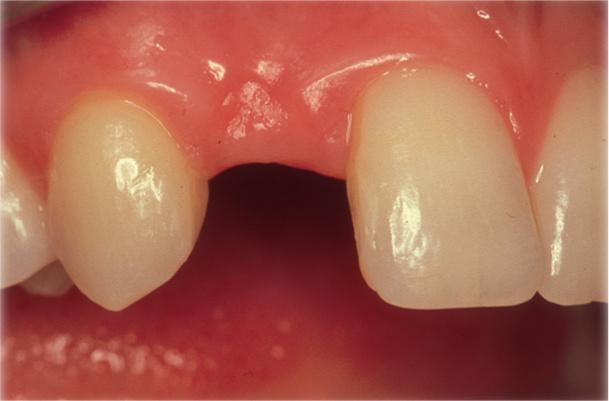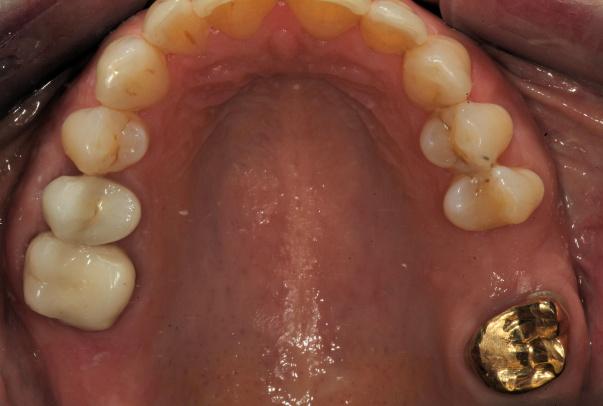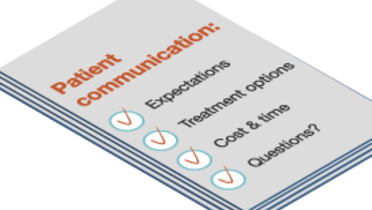-
0
Patient Assessment
- 0.1 Patient Demand
- 0.2 Anatomical location
-
0.3
Patient History
- 2.1 General patient history
- 2.2 Local history
-
0.4
Risk Assessment
- 3.1 Risk Assessment Overview
- 3.2 Age
- 3.3 Patient Compliance
- 3.4 Smoking
- 3.5 Drug Abuse
- 3.6 Recreational Drug and Alcohol Abuse
- 3.7 Condition of Natural Teeth
- 3.8 Parafunctions
- 3.9 Diabetes
- 3.10 Anticoagulants
- 3.11 Osteoporosis
- 3.12 Bisphosphonates
- 3.13 MRONJ
- 3.14 Steroids
- 3.15 Radiotherapy
- 3.16 Risk factors
-
1
Diagnostics
-
2
Treatment Options
-
2.1
Treatment planning
- 0.1 Non-implant based treatment options
- 0.2 Treatment planning conventional, model based, non-guided, semi-guided
- 0.3 Digital treatment planning
- 0.4 NobelClinician and digital workflow
- 0.5 Implant position considerations overview
- 0.6 Soft tissue condition and morphology
- 0.7 Site development, soft tissue management
- 0.8 Hard tissue and bone quality
- 0.9 Site development, hard tissue management
- 0.10 Time to function
- 0.11 Submerged vs non-submerged
- 0.12 Healed or fresh extraction socket
- 0.13 Screw-retained vs. cement-retained
- 0.14 Angulated Screw Channel system (ASC)
- 2.2 Treatment options esthetic zone
- 2.3 Treatment options posterior zone
- 2.4 Comprehensive treatment concepts
-
2.1
Treatment planning
-
3
Treatment Procedures
-
3.1
Treatment procedures general considerations
- 0.1 Anesthesia
- 0.2 peri-operative care
- 0.3 Flap- or flapless
- 0.4 Non-guided protocol
- 0.5 Semi-guided protocol
- 0.6 Guided protocol overview
- 0.7 Guided protocol NobelGuide
- 0.8 Parallel implant placement considerations
- 0.9 Tapered implant placement considerations
- 0.10 3D implant position
- 0.11 Implant insertion torque
- 0.12 Intra-operative complications
- 0.13 Impression procedures, digital impressions, intraoral scanning
- 3.2 Treatment procedures esthetic zone surgical
- 3.3 Treatment procedures esthetic zone prosthetic
- 3.4 Treatment procedures posterior zone surgical
- 3.5 Treatment procedures posterior zone prosthetic
-
3.1
Treatment procedures general considerations
-
4
Aftercare
Alternative treatment options
Key points
- There are several treatment options for replacing a single missing tooth; the choice is influenced by clinical, surgeon, dentist and patient factors.
- Treatment options for a single missing tooth are an implant-supported crown, a 3-unit bridge supported by two natural teeth, a fixed resin-bonded bridge, a removable partial denture, orthodontic closure of the open space and no treatment.
Alternative treatment options
There are several treatment options for a single missing tooth; the most common are an implant-supported crown, a 3-unit fixed partial denture supported by two natural teeth, a fixed resin-bonded fixed partial denture, a removable partial denture, orthodontic closure of the open space and no treatment.
Choices are influenced by:
- clinical factors, e.g. condition of remaining dentition, occlusal dimensions, degree of resorption of bone;
- surgeon and dentist factors, e.g. knowledge of treatment possibilities, skillfulness to perform every kind of treatment;
- patient factors, e.g. accessibility to state-of-art dental treatment, dental awareness, the position of the open space (anterior or posterior), anxiety for (surgical) dental procedures, financial aspects.
Implant-supported restorations have a good prognosis, high patient satisfaction, and the advantage that adjacent teeth are not involved in the treatment. Anxiety about surgical treatment, the position of the single-tooth space, and financial aspects may be reasons not to consider an implant-supported crown as first-choice treatment.
Patient expectation management and guidance
Understanding and successfully managing patient expectations is the most important predictor of patient satisfaction. The clinician should listen very carefully and evaluate how a patient expresses demands and how the patient adapts their expectations after hearing what can and cannot be achieved by different treatment options. One should not overpromise treatment possibilities. To that end, during the discussion of treatment options and the key factors associated with each option, the following concepts should be presented to the patient:
- what is possible to achieve and what is not
- prognostic factors
- patient time, treatment times and timelines
- temporary discomfort
- morbidity
- risks and prognostic factors for long-term success
- costs and eventual reimbursements
The occurrence and response to the treatment options discussion must be documented in the patient record including a review of the different treatment options presented. Treatment options have to be discussed with the patient. Different factors may have different levels of importance to the patient, as well as clinically, depending on the missing tooth position.

Figure 1: Missing tooth in position 12 (#7 UNIV)

Figure 2: Missing tooth in position 26 (#14 UNIV)


